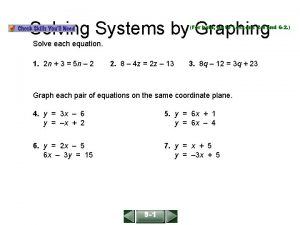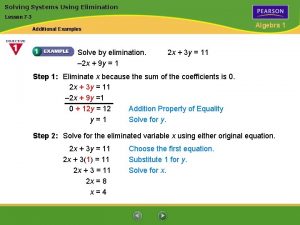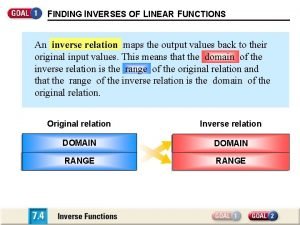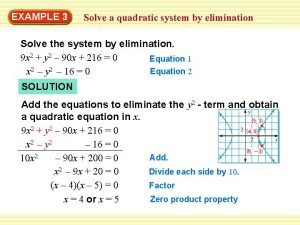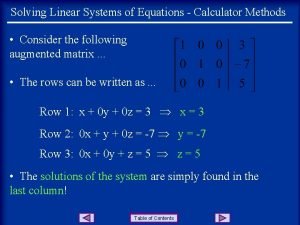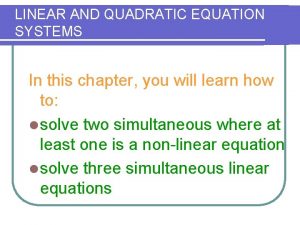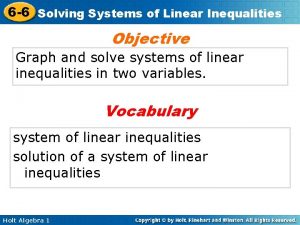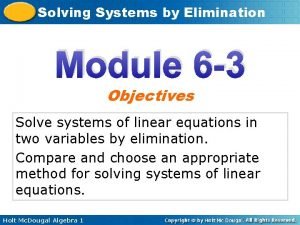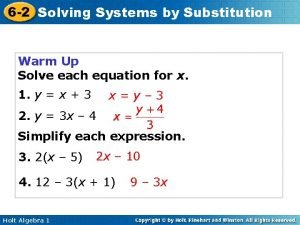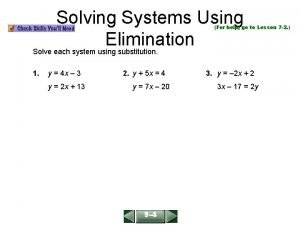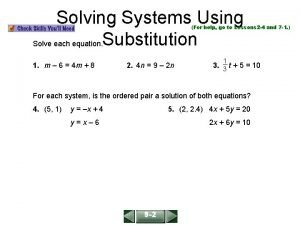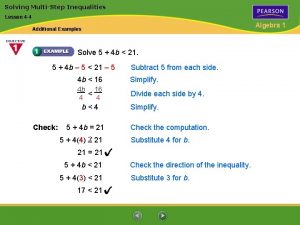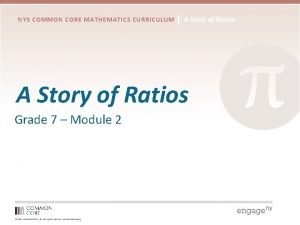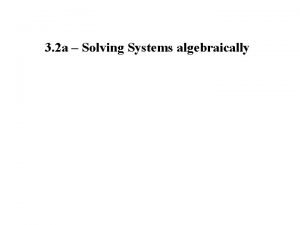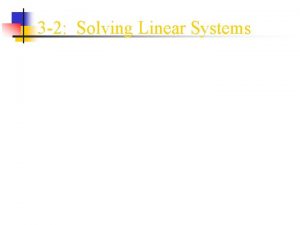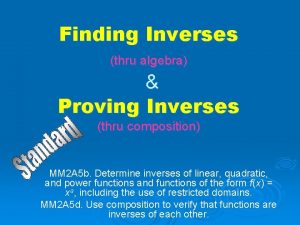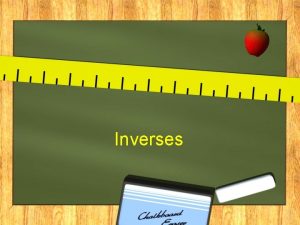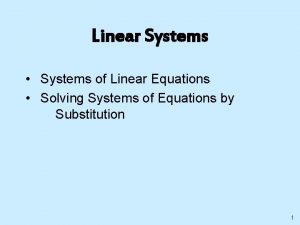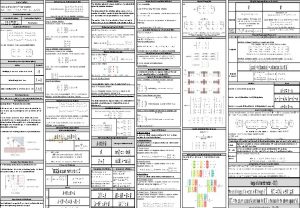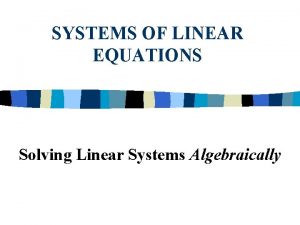LESSON 6 3 Solving Linear Systems Using Inverses

































- Slides: 33

LESSON 6– 3 Solving Linear Systems Using Inverses and Cramer’s Rule

Five-Minute Check (over Lesson 6 -2) Then/Now New Vocabulary Key Concept: Invertible Square Linear Systems Example 1: Solve a 2 × 2 System Using an Inverse Matrix Example 2: Real-World Example: Solve a 3 × 3 System Using an Inverse Matrix Key Concept: Cramer’s Rule Example 3: Use Cramer’s Rule to Solve a 2 × 2 System Example 4: Use Cramer’s Rule to Solve a 3 × 3 System

Over Lesson 6 -2 Find AB and BA, if possible. A. BA is not possible; AB = B. AB is not possible; BA = C. AB = ; BA = D. AB is not possible; BA is not possible

Over Lesson 6 -2 Write the system of equations as a matrix equation, AX = B. Then use Gauss-Jordan elimination on the augmented matrix to solve for X. x 1 + 2 x 2 + 3 x 3 = – 5 2 x 1 + x 2 + x 3 = 1 x 1 + x 2 – x 3 = 8


Over Lesson 6 -2 For and , find AB and BA and determine whether A and B are inverse matrices. A. B. C. D.

Over Lesson 6 -2 Which of the following represents the determinant of A. 0 B. 13 C. 15 D. 17 ?

You found determinants and inverses of 2 × 2 and 3 × 3 matrices. (Lesson 6 -2) • Solve systems of linear equations using inverse matrices. • Solve systems of linear equations using Cramer’s Rule.

• square system • Cramer’s Rule


Solve a 2 × 2 System Using an Inverse Matrix A. Use an inverse matrix to solve the system of equations, if possible. 2 x – y = 1 2 x + 3 y = 13 Write the system in matrix form AX = B.

Solve a 2 × 2 System Using an Inverse Matrix Use the formula for the inverse of a 2 × 2 matrix to find the inverse A– 1 Formula for the inverse of a 2 × 2 matrix. a = 2, b = – 1, c = 2, and d=3 Simplify.

Solve a 2 × 2 System Using an Inverse Matrix Multiply A– 1 by B to solve the system. X = A– 1 B Therefore, the solution of the system is (2, 3). Answer: (2, 3)

Solve a 2 × 2 System Using an Inverse Matrix B. Use an inverse matrix to solve the system of equations, if possible. 2 x + y = 9 x – 3 y + 2 z = 12 5 y – 3 z = – 11 Write the system in matrix form AX = B

Solve a 2 × 2 System Using an Inverse Matrix Use a graphing calculator to find A– 1 Multiply A– 1 by B to solve the system.

Solve a 2 × 2 System Using an Inverse Matrix X = A– 1 B Answer: (5, – 1, 2)

Use an inverse matrix to solve the system of equations, if possible. 2 x – 3 y = – 7 –x – y = 1 A. (– 2, 1) B. (2, – 1) C. (– 2, – 1) D. no solution

Solve a 3 × 3 System Using an Inverse Matrix COINS Marquis has 22 coins that are all nickels, dimes, and quarters. The value of the coins is $2. 75. He has three fewer dimes than twice the number of quarters. How many of each type of coin does Marquis have? His collection of coins can be represented by n + d + q = 22 5 n + 10 d + 25 q = 275 d – 2 q = – 3, where n, d, and q represent the number of nickels, dimes, and quarters, respectively. Write the system in matrix form AX = B.

Solve a 3 × 3 System Using an Inverse Matrix Use a graphing calculator to find A– 1

Solve a 3 × 3 System Using an Inverse Matrix Multiply A– 1 by B to solve the system. A– 1 B Answer: 7 nickels, 9 dimes, and 6 quarters

MUSIC Manny has downloaded three types of music: country, jazz, and rap. He downloaded a total of 24 songs. Each country song costs $0. 75 to download, each jazz song costs $1 to download, and each rap song costs $1. 10 to download. In all he has spent $23. 95 on his downloads. If Manny has downloaded two more jazz songs than country songs, how many of each kind of music has he downloaded? A. 6 country, 8 jazz, 10 rap B. 4 country, 6 jazz, 14 rap C. 5 country, 7 jazz, 12 rap D. 7 country, 9 jazz, 9 rap


Use Cramer’s Rule to Solve a 2 × 2 System Use Cramer’s Rule to find the solution to the system of linear equations, if a unique solution exists. 4 x 1 – 5 x 2 = – 49 – 3 x 1 + 2 x 2 = 28 The coefficient matrix is determinant of A. 4(2) – (– 5)(– 3) or – 7 . Calculate the

Use Cramer’s Rule to Solve a 2 × 2 System Because the determinant of A does not equal zero, you can apply Cramer’s Rule. So, the solution is x 1 = – 6 and x 2 = 5 or (– 6, 5). Check your answer in the original system. Answer: (– 6, 5)

Use Cramer’s Rule to find the solution of the system of linear equations, if a unique solution exists. – 6 x + 2 y = 28 x – 5 y = – 14 A. no solution B. (– 4, – 2) C. (4, – 2) D. (– 4, 2)

Use Cramer’s Rule to Solve a 3 × 3 System Use Cramer’s Rule to find the solution of the system of linear equations, if a unique solution exists. y + 4 z = – 1 2 x – 2 y + z = – 18 x – 4 z = 7 The coefficient matrix is the determinant of A. . Calculate

Use Cramer’s Rule to Solve a 3 × 3 System Formula for the determinant of a 3 × 3 matrix Simplify.

Use Cramer’s Rule to Solve a 3 × 3 System Because the determinant of A does not equal zero, you can apply Cramer’s Rule.

Use Cramer’s Rule to Solve a 3 × 3 System

Use Cramer’s Rule to Solve a 3 × 3 System Therefore, the solution is x = – 1, y = 7, and z = – 2 or (– 1, 7, – 2) Answer: (– 1, 7, – 2)

Use Cramer’s Rule to Solve a 3 × 3 System CHECK Check the solution by substituting back into the original system. ? 7 + 4(– 2) = – 1 ? 2(– 1) – 2(7) + – 2 = – 18 ? – 1 – 4(– 2) = 7 7 = 7

Use Cramer’s Rule to find the solution of the system of linear equations, if a unique solution exists. x – y + 2 z = – 3 – 2 x – z = 3 3 y + z = 10 A. (2, – 3, – 1) B. (– 2, 3, 1) C. (2, 3, 1) D. no solution

LESSON 6– 3 Solving Linear Systems Using Inverses and Cramer’s Rule
 6-3 solving linear systems using inverses and cramer's rule
6-3 solving linear systems using inverses and cramer's rule Lesson 9.1 solving linear systems by graphing answer key
Lesson 9.1 solving linear systems by graphing answer key 11.1 solving linear systems by graphing
11.1 solving linear systems by graphing Lesson 7: how to solve basic algebraic equations
Lesson 7: how to solve basic algebraic equations Inverse of linear functions
Inverse of linear functions 6-2 inverse functions and relations
6-2 inverse functions and relations Bounded or unbounded graph
Bounded or unbounded graph How to solve quadratic equations by elimination
How to solve quadratic equations by elimination Solving linear systems graphically assignment
Solving linear systems graphically assignment System of inequalities quiz part 1
System of inequalities quiz part 1 Solving linear equations calculator
Solving linear equations calculator Solving linear quadratic systems
Solving linear quadratic systems Solving systems of linear and quadratic equations
Solving systems of linear and quadratic equations 6-6 solving systems of linear inequalities
6-6 solving systems of linear inequalities Solving systems using tables and graphs
Solving systems using tables and graphs 6-3 solving systems using elimination
6-3 solving systems using elimination Solving word problems using systems of equations
Solving word problems using systems of equations 3-6 solving systems using matrices
3-6 solving systems using matrices 5-3 solving systems by elimination
5-3 solving systems by elimination 3-1 solving systems using tables and graphs
3-1 solving systems using tables and graphs 6-3 solving systems using elimination
6-3 solving systems using elimination Lesson 6-2 solving systems by substitution
Lesson 6-2 solving systems by substitution Use elimination to solve each system of equations
Use elimination to solve each system of equations 6-2 solving systems using substitution
6-2 solving systems using substitution 6-3 solving systems using elimination
6-3 solving systems using elimination Lesson 4 - solving linear equations and inequalities
Lesson 4 - solving linear equations and inequalities Lesson 4-2 absolute value inequalities
Lesson 4-2 absolute value inequalities 1-2 lesson quiz solving linear equations
1-2 lesson quiz solving linear equations 2-1 solving linear equations and inequalities
2-1 solving linear equations and inequalities Lesson 1-2 solving linear equations
Lesson 1-2 solving linear equations Lesson 23 solving equations using algebra
Lesson 23 solving equations using algebra Lesson 6-4 solving special systems answer key
Lesson 6-4 solving special systems answer key Lesson 3-4 solving matrix equations
Lesson 3-4 solving matrix equations 3-2 solving systems algebraically
3-2 solving systems algebraically

